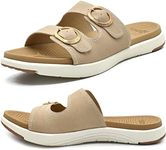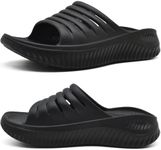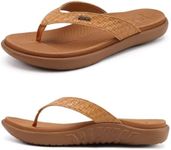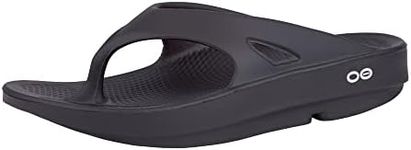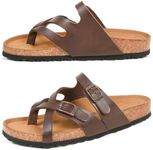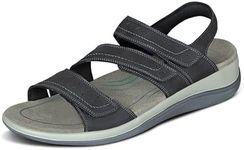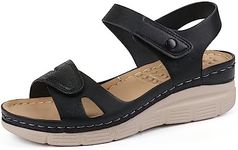Buying Guide for the Best Womens Sandals For Plantar Fasciitis
Choosing the right women's sandals for plantar fasciitis is all about finding footwear that provides excellent support, comfort, and relief from heel pain. Plantar fasciitis is a common condition that causes pain in the heel and bottom of the foot, so sandals need to offer features that help reduce strain and promote proper foot alignment. When shopping, focus on sandals designed with supportive structures and cushioning, and always consider your daily activities and how long you'll be wearing them. Trying on different styles and paying attention to how your feet feel can help you find the best fit for your needs.Arch SupportArch support refers to the way a sandal supports the natural curve of your foot. This is crucial for plantar fasciitis because proper arch support helps distribute pressure evenly and reduces strain on the plantar fascia ligament. Sandals can have minimal, moderate, or high arch support. Minimal support is usually found in flat sandals and is not recommended for plantar fasciitis. Moderate support offers some contouring and is suitable for mild cases or short-term wear. High arch support provides a pronounced curve and is best for those with significant pain or flat feet. To pick the right level, consider how much support your feet need based on your pain level and foot shape—if you have flat feet or severe pain, opt for higher arch support.
CushioningCushioning is the softness and shock absorption provided by the sandal's footbed. Good cushioning helps absorb impact when you walk, reducing stress on your heel and the plantar fascia. Sandals can range from firm to plush cushioning. Firm cushioning offers stability but less softness, while plush cushioning feels softer underfoot but may be less supportive if too squishy. For plantar fasciitis, look for sandals with a balance—enough cushioning to absorb shock but not so much that your foot sinks in and loses support. If you spend a lot of time on hard surfaces or have sensitive feet, prioritize more cushioning.
Heel Support and HeightHeel support refers to how well the sandal cradles and stabilizes your heel, while heel height is the elevation of the heel compared to the toe. Proper heel support keeps your foot in place and prevents excessive movement that can worsen plantar fasciitis. Heel height can be flat, low (about 1 inch), or moderate (1-2 inches). Completely flat sandals can increase strain, while a slight heel can relieve pressure on the plantar fascia. Choose sandals with a contoured heel cup and a slight elevation for the best comfort and support.
AdjustabilityAdjustability means how well you can customize the fit of the sandal using straps, buckles, or Velcro. This is important because a secure fit prevents your foot from sliding and keeps the arch and heel support in the right place. Sandals may have no adjustability, a single adjustable strap, or multiple adjustable points. For plantar fasciitis, multiple adjustable straps are ideal, as they allow you to fine-tune the fit across your foot and accommodate swelling or changes in foot shape throughout the day.
Sole Material and TractionThe sole material affects the durability, flexibility, and grip of the sandal. A good sole should be sturdy enough to provide support but flexible enough to allow natural movement. Traction refers to how well the sandal grips the ground, which is important for safety and stability. Soles can be made from rubber, EVA, or other synthetic materials. Rubber soles usually offer the best grip and durability, while EVA is lightweight and cushioned. For plantar fasciitis, look for sandals with a supportive, non-slip sole to prevent falls and provide a stable walking experience.

